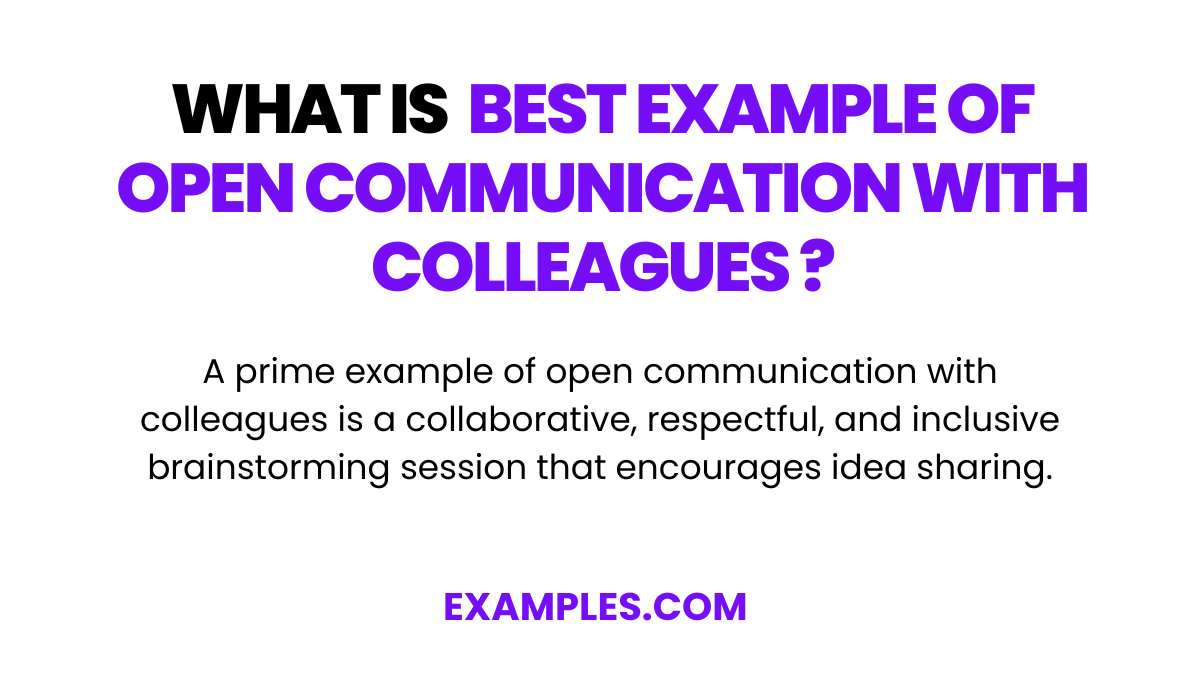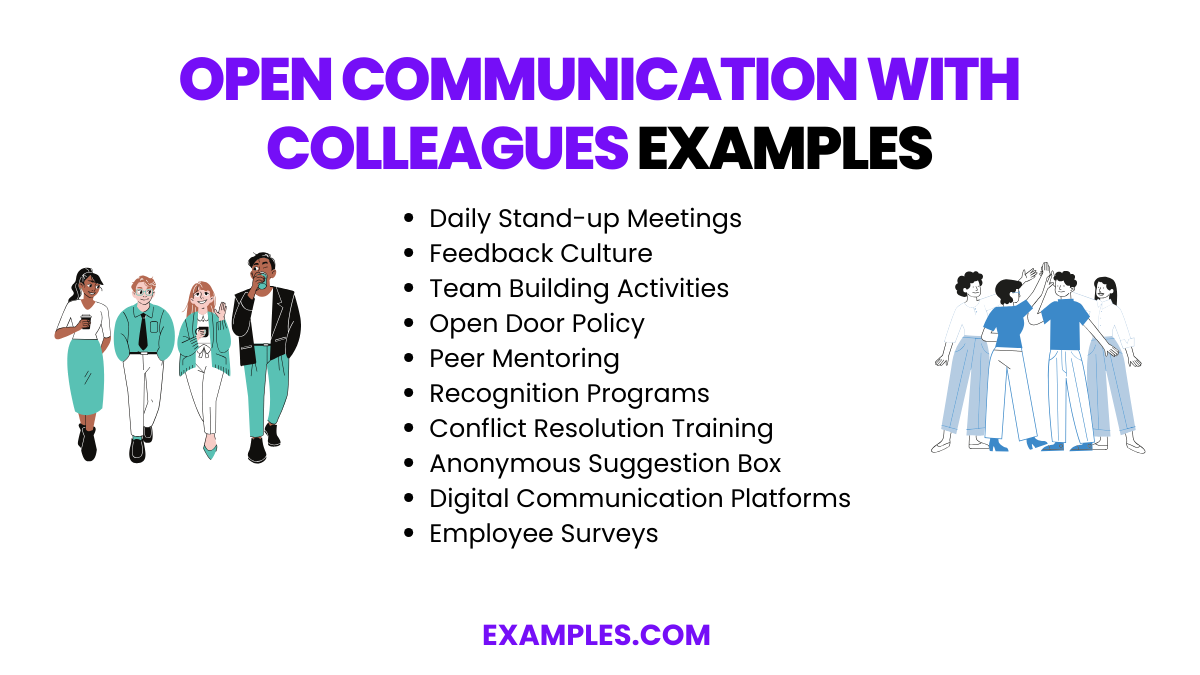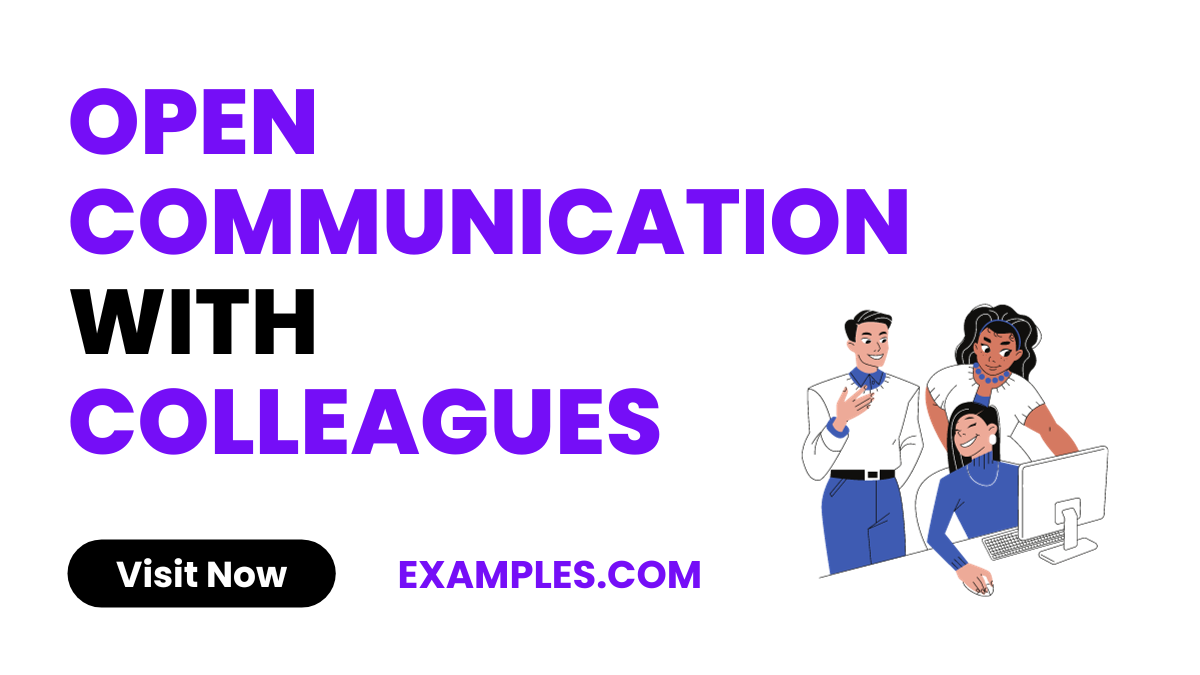20+ Open Communication with Colleagues Examples
Navigate the world of workplace harmony with our Open Communication with Colleagues guide, featuring real-life Communication Examples. This guide is a treasure trove for anyone looking to foster a transparent, supportive, and collaborative environment. Enhance your professional relationships and team dynamics through the power of open dialogue, ensuring a productive and positive workplace for all.
Download Open Communication with Colleagues Questions and Answers PDF
What is Open Communication with Colleagues? – Meaning

Open Communication with Colleagues means engaging in honest, transparent, and constructive dialogue within the workplace. It involves expressing thoughts and ideas clearly, actively listening, and respecting diverse opinions. This form of communication is essential in building trust, fostering collaboration, and ensuring a cohesive team. It’s about creating a space where everyone feels valued and heard, leading to more effective and harmonious working relationships.
What is the Best Example of Open Communication with Colleagues?

A prime example of Open Communication with colleagues is a team brainstorming session where all members are encouraged to share their ideas and thoughts freely. Here, a facilitator ensures that everyone’s voice is heard, and feedback is given constructively. For instance, when tackling a project challenge, each member presents their perspective, and the team discusses each idea with respect and consideration. This scenario not only solves the problem efficiently but also strengthens the team’s bond and trust.
20 Open Communication with Colleagues Examples

Delve into the myriad of ways Open Communication with Colleagues can revolutionize your workplace. With these 20 unique examples, understand the catalysts and remedies for common communication breakdowns. Embracing the principles of Open Communication in the Workplace and recognizing the Importance of Open Communication can lead to enhanced collaboration, trust, and productivity. These examples serve as a blueprint for fostering a culture of transparency and mutual respect, embodying the very essence of Honest Communication.
- Daily Stand-up Meetings: Daily brief team meetings to share updates and hurdles.
- Cause: Lack of regular communication can lead to misinformation.
- Fix: Ensures everyone is on the same page, reflecting the Open Communication Benefits.
- Feedback Culture: Encourage and train staff to give and receive constructive feedback.
- Cause: Fear or unawareness of how to provide feedback.
- Fix: Builds a robust feedback mechanism akin to Open Communication in Leadership.
- Team Building Activities: Regular team outings or problem-solving games.
- Cause: Silos and lack of team bonding.
- Fix: Encourages team unity and Open Communication in the Workplace.
- Open Door Policy: Leaders make themselves available for any discussions.
- Cause: Hierarchical barriers to communication.
- Fix: Promotes approachability and Open Communication in Relationship at work.
- Peer Mentoring: Pairing employees for mutual learning and support.
- Cause: Lack of support among colleagues.
- Fix: Fosters a helping culture, echoing Open Communication in Family.
- Recognition Programs: Acknowledging and celebrating team and individual successes.
- Cause: Lack of motivation or feeling undervalued.
- Fix: Boosts morale and emphasizes the Importance of Open Communication.
- Conflict Resolution Training: Workshops on handling disputes constructively.
- Cause: Inadequate conflict management skills.
- Fix: Equips employees with strategies for Honest Communication.
- Anonymous Suggestion Box: A channel for employees to share ideas or concerns anonymously.
- Cause: Fear of reprisal or embarrassment.
- Fix: Allows a safe space for feedback, reflecting Open Mind Communication.
- Digital Communication Platforms: Use of team chat apps for easier collaboration.
- Cause: Physical or hierarchical barriers to communication.
- Fix: Streamlines communication, a nod to How to Promote Open Communication.
- Employee Surveys: Regular surveys to gauge workplace climate and needs.
- Cause: Unaddressed employee concerns or suggestions.
- Fix: Provides insights and fosters a culture of Open Communication in Healthcare.
Open Communication with Colleagues in Workplace
Achieve Open Communication with Colleagues in Workplace to enhance transparency and morale. Embrace strategies akin to Open Communication with Manager and ensure Open Communication with Stakeholders for organizational success. These examples illustrate methods to foster a communicative, collaborative work environment.
- Regular One-on-One Meetings: Weekly personal discussions to address individual concerns.
- Cross-Departmental Meetings: Sessions for aligning goals across teams.
- Skill Sharing Sessions: Monthly presentations by team members on various skills.
- Company Town Halls: Quarterly meetings for company updates and open Q&A.
- Feedback Mechanism for Leadership: Anonymous forms for direct management feedback.
How can Organizations Promote and Encourage Open Communication with Colleagues among their Employees?
Organizations thrive when communication is clear and open, akin to the trust found in Open Communication with Parents. Promoting these values in the workplace can lead to enhanced cooperation, much like the nurturing understanding seen in Open Communication with Child.
- Establish Clear Communication Policies: Develop comprehensive communication guidelines that are as transparent as the dialogues in Open Communication with Patients, ensuring every team member understands the importance of open dialogue.
- Provide Communication Training: Offer workshops and training sessions to build skills necessary for effective communication, much like the learning support provided in Open Communication with Students.
- Implement Feedback Systems: Create platforms for employees to give and receive feedback openly, fostering a culture of continuous improvement and mutual respect.
- Encourage Cross-Departmental Interactions: Facilitate regular meetings between different teams to enhance understanding and collaboration, much like family gatherings that promote Open Communication with Parents.
- Model Open Communication from the Top: Leaders should actively engage in open dialogue, setting a precedent for all employees to follow, just as a parent models Open Communication with Child.
Why is Open Communication with Colleagues Considered a Cornerstone of Effective Teamwork?
Open communication is the bedrock of team efficiency and unity, much like the fundamental role it plays in Open Communication with Students. It ensures all team members are aligned and collaborative.
- Builds Trust: Just as trust is essential in Open Communication with Patients, it’s crucial among colleagues, fostering a safe and supportive work environment where ideas can be shared freely.
- Enhances Problem-Solving: Teams that communicate openly can address and resolve issues more efficiently, drawing on diverse perspectives and collective wisdom.
- Improves Morale: Regular, honest dialogue boosts team spirit and motivation, similar to the positive atmosphere nurtured in Open Communication with Child.
- Fosters Innovation: Open communication encourages creativity and the sharing of new ideas, just as Open Communication with Students inspires fresh thinking and learning.
- Facilitates Change Management: Effective communication is key in navigating and adapting to change smoothly, ensuring that everyone is on the same page throughout transitions.
How did you Demonstrate Open Communication Skills with your Colleague?
In a recent project, I exhibited open communication skills by actively engaging my colleague in discussions, encouraging them to share their ideas, and listening attentively. We clarified our Communication Roles, ensuring each team member’s responsibilities were clear. Through regular Communication Analysis, we identified areas for improvement, enabling us to adapt and enhance our collaboration for better project outcomes.
1. How to Openly Communicate with Colleagues Interview Questions
Engage in active listening, express ideas clearly, ask open-ended questions, and use non-verbal cues. Discuss Open Communication vs Closed Communication when relevant.
2. Challenges in Maintaining Open Communication with Colleagues
Overcoming miscommunication, addressing conflicts diplomatically, balancing privacy concerns, and navigating cultural differences. Highlight Open Communication vs Direct Communication as a solution.
3. How Open Communication Enhances Workplace Productivity
Fosters teamwork, reduces misunderstandings, encourages innovation, and boosts morale. Emphasize the Importance of Open Communication in Relationships for professional success.
In conclusion, embracing open communication with colleagues is pivotal for a harmonious and productive work environment. This article explored examples of effective communication, its positive effects on teamwork, identifiable signs of open dialogue, and practical solutions for improvement. By fostering transparent and respectful communication, organizations can enhance collaboration, innovation, and employee satisfaction, ultimately leading to a more successful and cohesive workplace.
20+ Open Communication with Colleagues Examples

Navigate the world of workplace harmony with our Open Communication with Colleagues guide, featuring real-life Communication Examples. This guide is a treasure trove for anyone looking to foster a transparent, supportive, and collaborative environment. Enhance your professional relationships and team dynamics through the power of open dialogue, ensuring a productive and positive workplace for all.
Download Open Communication with Colleagues Questions and Answers PDF
What is Open Communication with Colleagues? – Meaning

Open Communication with Colleagues means engaging in honest, transparent, and constructive dialogue within the workplace. It involves expressing thoughts and ideas clearly, actively listening, and respecting diverse opinions. This form of communication is essential in building trust, fostering collaboration, and ensuring a cohesive team. It’s about creating a space where everyone feels valued and heard, leading to more effective and harmonious working relationships.
What is the Best Example of Open Communication with Colleagues?

A prime example of Open Communication with colleagues is a team brainstorming session where all members are encouraged to share their ideas and thoughts freely. Here, a facilitator ensures that everyone’s voice is heard, and feedback is given constructively. For instance, when tackling a project challenge, each member presents their perspective, and the team discusses each idea with respect and consideration. This scenario not only solves the problem efficiently but also strengthens the team’s bond and trust.
20 Open Communication with Colleagues Examples

Delve into the myriad of ways Open Communication with Colleagues can revolutionize your workplace. With these 20 unique examples, understand the catalysts and remedies for common communication breakdowns. Embracing the principles of Open Communication in the Workplace and recognizing the Importance of Open Communication can lead to enhanced collaboration, trust, and productivity. These examples serve as a blueprint for fostering a culture of transparency and mutual respect, embodying the very essence of Honest Communication.
Daily Stand-up Meetings: Daily brief team meetings to share updates and hurdles.
Cause: Lack of regular communication can lead to misinformation.
Fix: Ensures everyone is on the same page, reflecting the Open Communication Benefits.
Feedback Culture: Encourage and train staff to give and receive constructive feedback.
Cause: Fear or unawareness of how to provide feedback.
Fix: Builds a robust feedback mechanism akin to Open Communication in Leadership.
Team Building Activities: Regular team outings or problem-solving games.
Cause: Silos and lack of team bonding.
Fix: Encourages team unity and Open Communication in the Workplace.
Open Door Policy: Leaders make themselves available for any discussions.
Cause: Hierarchical barriers to communication.
Fix: Promotes approachability and Open Communication in Relationship at work.
Peer Mentoring: Pairing employees for mutual learning and support.
Cause: Lack of support among colleagues.
Fix: Fosters a helping culture, echoing Open Communication in Family.
Recognition Programs: Acknowledging and celebrating team and individual successes.
Cause: Lack of motivation or feeling undervalued.
Fix: Boosts morale and emphasizes the Importance of Open Communication.
Conflict Resolution Training: Workshops on handling disputes constructively.
Cause: Inadequate conflict management skills.
Fix: Equips employees with strategies for Honest Communication.
Anonymous Suggestion Box: A channel for employees to share ideas or concerns anonymously.
Cause: Fear of reprisal or embarrassment.
Fix: Allows a safe space for feedback, reflecting Open Mind Communication.
Digital Communication Platforms: Use of team chat apps for easier collaboration.
Cause: Physical or hierarchical barriers to communication.
Fix: Streamlines communication, a nod to How to Promote Open Communication.
Employee Surveys: Regular surveys to gauge workplace climate and needs.
Cause: Unaddressed employee concerns or suggestions.
Fix: Provides insights and fosters a culture of Open Communication in Healthcare.
Open Communication with Colleagues in Workplace
Achieve Open Communication with Colleagues in Workplace to enhance transparency and morale. Embrace strategies akin to Open Communication with Manager and ensure Open Communication with Stakeholders for organizational success. These examples illustrate methods to foster a communicative, collaborative work environment.
Regular One-on-One Meetings: Weekly personal discussions to address individual concerns.
Cross-Departmental Meetings: Sessions for aligning goals across teams.
Skill Sharing Sessions: Monthly presentations by team members on various skills.
Company Town Halls: Quarterly meetings for company updates and open Q&A.
Feedback Mechanism for Leadership: Anonymous forms for direct management feedback.
How can Organizations Promote and Encourage Open Communication with Colleagues among their Employees?
Organizations thrive when communication is clear and open, akin to the trust found in Open Communication with Parents. Promoting these values in the workplace can lead to enhanced cooperation, much like the nurturing understanding seen in Open Communication with Child.
Establish Clear Communication Policies: Develop comprehensive communication guidelines that are as transparent as the dialogues in Open Communication with Patients, ensuring every team member understands the importance of open dialogue.
Provide Communication Training: Offer workshops and training sessions to build skills necessary for effective communication, much like the learning support provided in Open Communication with Students.
Implement Feedback Systems: Create platforms for employees to give and receive feedback openly, fostering a culture of continuous improvement and mutual respect.
Encourage Cross-Departmental Interactions: Facilitate regular meetings between different teams to enhance understanding and collaboration, much like family gatherings that promote Open Communication with Parents.
Model Open Communication from the Top: Leaders should actively engage in open dialogue, setting a precedent for all employees to follow, just as a parent models Open Communication with Child.
Why is Open Communication with Colleagues Considered a Cornerstone of Effective Teamwork?
Open communication is the bedrock of team efficiency and unity, much like the fundamental role it plays in Open Communication with Students. It ensures all team members are aligned and collaborative.
Builds Trust: Just as trust is essential in Open Communication with Patients, it’s crucial among colleagues, fostering a safe and supportive work environment where ideas can be shared freely.
Enhances Problem-Solving: Teams that communicate openly can address and resolve issues more efficiently, drawing on diverse perspectives and collective wisdom.
Improves Morale: Regular, honest dialogue boosts team spirit and motivation, similar to the positive atmosphere nurtured in Open Communication with Child.
Fosters Innovation: Open communication encourages creativity and the sharing of new ideas, just as Open Communication with Students inspires fresh thinking and learning.
Facilitates Change Management: Effective communication is key in navigating and adapting to change smoothly, ensuring that everyone is on the same page throughout transitions.
How did you Demonstrate Open Communication Skills with your Colleague?
In a recent project, I exhibited open communication skills by actively engaging my colleague in discussions, encouraging them to share their ideas, and listening attentively. We clarified our Communication Roles, ensuring each team member’s responsibilities were clear. Through regular Communication Analysis, we identified areas for improvement, enabling us to adapt and enhance our collaboration for better project outcomes.
1. How to Openly Communicate with Colleagues Interview Questions
Engage in active listening, express ideas clearly, ask open-ended questions, and use non-verbal cues. Discuss Open Communication vs Closed Communication when relevant.
2. Challenges in Maintaining Open Communication with Colleagues
Overcoming miscommunication, addressing conflicts diplomatically, balancing privacy concerns, and navigating cultural differences. Highlight Open Communication vs Direct Communication as a solution.
3. How Open Communication Enhances Workplace Productivity
Fosters teamwork, reduces misunderstandings, encourages innovation, and boosts morale. Emphasize the Importance of Open Communication in Relationships for professional success.
In conclusion, embracing open communication with colleagues is pivotal for a harmonious and productive work environment. This article explored examples of effective communication, its positive effects on teamwork, identifiable signs of open dialogue, and practical solutions for improvement. By fostering transparent and respectful communication, organizations can enhance collaboration, innovation, and employee satisfaction, ultimately leading to a more successful and cohesive workplace.


